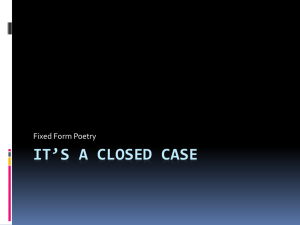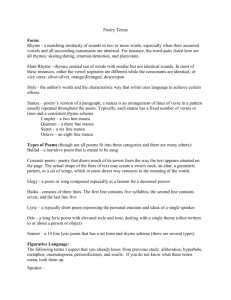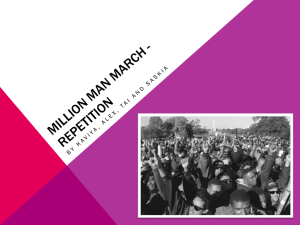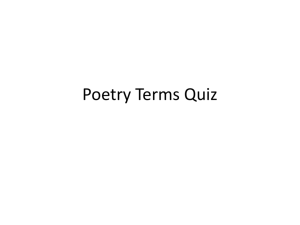AP-Poetry-Terms-amp-Some-Forms
advertisement
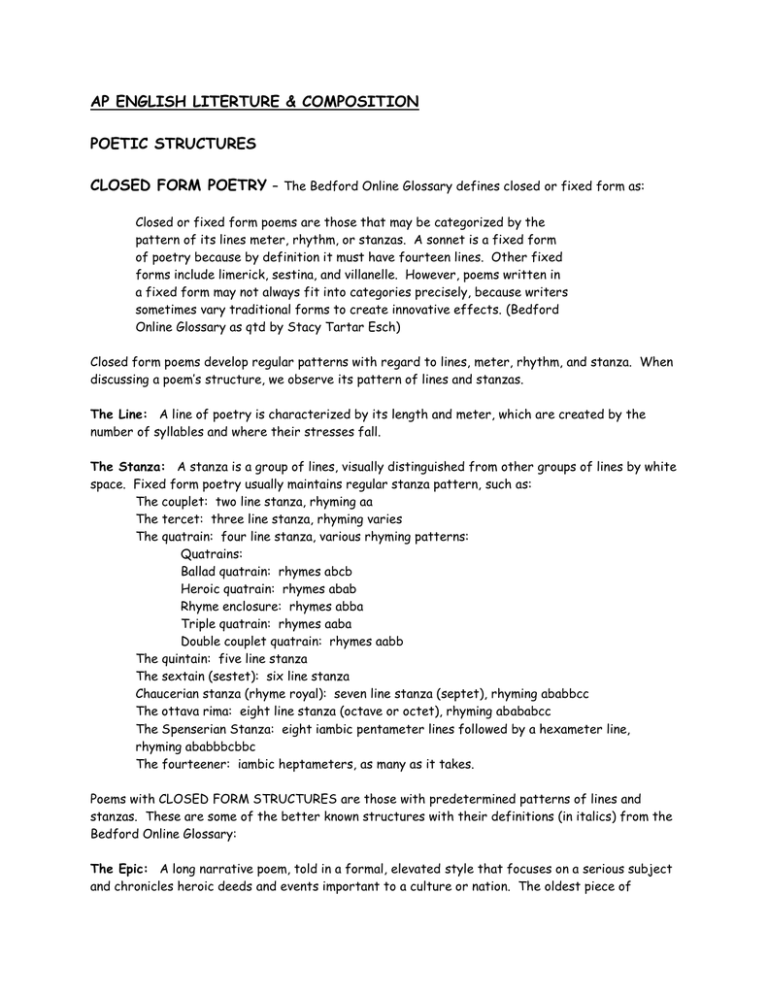
AP ENGLISH LITERTURE & COMPOSITION POETIC STRUCTURES CLOSED FORM POETRY – The Bedford Online Glossary defines closed or fixed form as: Closed or fixed form poems are those that may be categorized by the pattern of its lines meter, rhythm, or stanzas. A sonnet is a fixed form of poetry because by definition it must have fourteen lines. Other fixed forms include limerick, sestina, and villanelle. However, poems written in a fixed form may not always fit into categories precisely, because writers sometimes vary traditional forms to create innovative effects. (Bedford Online Glossary as qtd by Stacy Tartar Esch) Closed form poems develop regular patterns with regard to lines, meter, rhythm, and stanza. When discussing a poem’s structure, we observe its pattern of lines and stanzas. The Line: A line of poetry is characterized by its length and meter, which are created by the number of syllables and where their stresses fall. The Stanza: A stanza is a group of lines, visually distinguished from other groups of lines by white space. Fixed form poetry usually maintains regular stanza pattern, such as: The couplet: two line stanza, rhyming aa The tercet: three line stanza, rhyming varies The quatrain: four line stanza, various rhyming patterns: Quatrains: Ballad quatrain: rhymes abcb Heroic quatrain: rhymes abab Rhyme enclosure: rhymes abba Triple quatrain: rhymes aaba Double couplet quatrain: rhymes aabb The quintain: five line stanza The sextain (sestet): six line stanza Chaucerian stanza (rhyme royal): seven line stanza (septet), rhyming ababbcc The ottava rima: eight line stanza (octave or octet), rhyming abababcc The Spenserian Stanza: eight iambic pentameter lines followed by a hexameter line, rhyming ababbbcbbc The fourteener: iambic heptameters, as many as it takes. Poems with CLOSED FORM STRUCTURES are those with predetermined patterns of lines and stanzas. These are some of the better known structures with their definitions (in italics) from the Bedford Online Glossary: The Epic: A long narrative poem, told in a formal, elevated style that focuses on a serious subject and chronicles heroic deeds and events important to a culture or nation. The oldest piece of literature is the Epic of Gilgamesh. Homer’s Iliad and Odyssey are epics. In English literature, John Milton’s Paradise Lost is an epic. The Ode: A relatively lengthy lyric poem that often expresses lofty emotions in a dignified style. Odes are characterized by a serious topic, such as truth, art, freedom, justice, or the meaning of life; their tone tends to be formal. There is no prescribed pattern that defines an ode; some odes repeat the same pattern in each stanza, while others introduce a new pattern in each stanza. Some of the oldest odes are probably those written by the Greek poet, Pindar (Victory Odes). Two famous poems written by 19th century English Romantic poets are John Keats’ “Ode to a Nightingale” and Percy Bysshe Shelley’s “Ode to the West Wind.” The Ballad – Traditionally, a ballad is a song transmitted orally from generation to generation that tells a story and is eventually written down. As such, ballads usually cannot be traced to a particular author or group of authors. Typically, ballads are dramatic, condensed, and impersonal narratives, such as “Bonny Barbara Allan” or “House Carpenter.” A literary ballad is a narrative poem that is written in deliberate imitation of the language, form, and spirit of the traditional ballad, such as “Ballad of Birmingham” by Dudley Randall or “Ballad of the Landlord” by Langston Hughes. The Sonnet – A fixed form of lyric poetry that consists of fourteen lines, usually written in iambic pentameter. There are two basic types of sonnets, the Italian and the English. The Italian sonnet, or the Petrarchan sonnet, is divided into an octave, which typically rhymes abbaabba, and a sestet, which may have varying rhyme schemes, such as cdecde, cdcdcd, and cdccdc. Very often the octave presents a situation, attitude, or problem that the sestet comments upon or resolves, as in John Keats’ “On First Looking into Chapman’s Homer.” The English sonnet, also known as the Shakespearean sonnet, is organized into three quatrains and a couplet, which typically rhymes abab cdcd efef gg. This rhyme scheme is more suited to English poetry because English has fewer rhyming words than Italian. English sonnets, because of their four-part organization, also have more flexibility with respect to where the thematic breaks can occur, but usually the thematic break occurs in the final stanza, the couplet. Several famous sonnets include Percy Bysshe Shelley’s “Ozymandias,” William Wordsworth’s “The World is too Much with Us,” Mark Jarman’s “Unholy Sonnet 1,” and various Shakespeare sonnets, such as “Sonnet #130.” The Villanelle – A type of fixed form poetry consisting of nineteen lines of any length divided into six stanzas: five tercets and a concluding quatrain. The first and third lines of the initial tercet rhyme; these rhymes are repeated in each subsequent tercet (aba) and in the final two lines of the quatrain (abaa). Line 1 appears in its entirety as Lines 6, 12, and 18, while Line 3 reappears as Lines 9, 15, and 19. Dylan Thomas’ “Do Not Go Gentle into that Good Night” is a villanelle. The Haiku: A style of lyric poetry borrowed from the Japanese that typically presents an intense emotion or vivid image of nature, which, traditionally, is designed to lead to a spiritual insight. Haiku is a fixed poetic form, consisting of seventeen syllables, organized into three unrhymed lines of five, seven, and five syllables. Today, however, many poets vary the syllabic count in their haiku. The famous Japanese poet Basho created many haiku poems. The Sestina - Although the sestina usually does not rhyme, it is perhaps an even more demanding fixed form than the villanelle. A sestina consists of 39 lines of any length divided into six 6-line stanzas and a 3-line final stanza called an envoy. The 6 words at the ends of the 1 st stanza’s lines must be repeated in the ends of the lines in the other five 6-line stanzas. Those words must also appear in the final 3 lines, where they often resonate important themes. Although originated in the Middle Ages, contemporary poets continue to find its form fascinating and challenging. E.G. “Sestina” by Elizabeth Bishop. Other 20th century authors of sestinas are Ezra Pound, T.S. Eliot, and W.H. Auden. The Epigram – An epigram is a brief, pointed, and witty poem. Although most rhyme and often are written in couplets, epigrams take no prescribed form. Instead they are typically polished bits of compressed irony, satire, or paradox. E.G. “Coward” A.R. Ammons, “Epitaph on a Waiter” David McCord. Here is an epigram that defines itself: What is an epigram? A dwarfish whole; Its body brevity, and wit its soul. Samuel Taylor Coleridge 1802 The Limerick – The Limerick is always light and humorous. Its usual form consists of five mostly anapestic lines rhyming aabba; Lines 1, 2, & 5 contain 3 feet, while Lines 3 & 4 contain 2. Limericks delight all ages and range in subject matter from the simply innocent or silly to the satiric or obscene. The sexual humor helps to explain why so many limericks are written anonymously. E.G. “The limerick’s never averse” Laurence Perrine. Here is an anonymous one concerned with physics: There was a young lady named Bright, Who traveled much faster than light, She started one day In a relative way, And returned on the previous night. The Clerihew – The clerihew is another humorous fixed form that has enjoyed a modest reputation ever since Edmund Clerihew Bentley created it. The clerihew usually consists of 4 irregular lines rhyming aabb that comment on a famous person named in the first line. Here is an example from the creator himself. John Stuart Mill By a mighty effort of will Overcame his natural bonhomie And wrote Principles of Political Economy. The Elegy – The elegy in classical Greek and Roman literature was written in alternating hexameter and pentameter lines. Since the 17 th century, however, the term elegy has been used to describe a lyric poem written to commemorate someone who has died. The word is also used to refer to a serious meditative poem produced to express the speaker’s melancholy thoughts. Elegies no longer conform to a fixed pattern of lines and stanzas, but their characteristic subject is related to death and their tone is mournfully contemplative. E. G. “Mid-term Break” Seamus Heany. The Picture (or visual) Poem – The picture poem arranges lines into particular shapes. Poets can sometimes organize typography into picture poems of what they describe. George Herbert’s “Easter Wings” is an example. The Parody – A parody is a humorous imitation of another, usually serious, work. It can take any fixed or open form because parodists imitate the tone, language, and shape of the original. While a parody may be teasingly close to a work’s style, it typically deflates the subject matter to make the original seem absurd. Parody can be used as a kind of literary criticism to expose the defects in a work, but it is also very often an affectionate acknowledgement that a well-known work has become both institutionalized in our culture and fair game for some fun. Some originals and their parodies include: “To His Coy Mistress” Andrew Marvell /“To His Importunate Mistress” Peter DeVries “This is Just to Say” William Carlos Williams /“Variations on a Theme by William Carlos Williams” Kenneth Koch “Fog” Carl Sandburg / “Thunderstorm by Carl Sandburg’s Cat” Henry Beard “Death, Be not Proud” John Donne / “Vet, Be Not Proud by John Donne’s Cat” Henry Beard Lyric Poetry: Descriptive word used to describe a genre of poetry, such as evident in sonnets, odes, elegies, etc., which expresses the thoughts and feelings of the poet. It is highly personal and medodious; and it is filled with imagery. A lyric poem may resemble a song in form or style. OPEN FORM POETRY – The Bedford Online Glossary defines open form, or “free verse” poetry as follows: Sometimes called “free verse,” open form poetry does not conform to established patterns of meter, rhyme, and stanza. Such poetry derives its rhythmic qualities from the repetition of words, phrases, or grammatical structures, the arrangement of words on the printed page, or by some other means. The poet E. E. Cummings wrote open form poetry; his poems do not have measurable meters, but they do have rhythm. (Bedford Online Glossary as qtd by Stacy Tartar Esch) What distinguishes open form poems is that they do not develop regular patterns with regard to lines, meter, rhythm, and stanza. Their structure is more “organic” instead of being predetermined, following its own inner logic according to the emotion or thought expressed. A few open form poems to consider are two E. E. Cummings—“I(a” and “In just-.“ Another open form poem is Walt Whitman’s “When I Heard the Learned Astronomer.” Thanks to Stacy Tartar Esch of West Chester University for sharing resources for the above. POETRY TERMS Alliteration: repetition of consonant sounds at the beginning of words or accented syllables that are close to each other. Hopkins’ stanza provides some fine examples: “skylark scanted”; “Man’s mounting…mean house”; “free fells.” Always try to understand the reason for the alliteration. Does it speed or slow the rhythm? Is it there for emphasis? On what does the poet wish you to focus? Apostrophe: the direct address of someone or something that is not present. Many odes begin this way. Keats’ “Ode to a Grecian Urn” for example: “Thou still unravished bride of quietness,” and “Ode to Psyche”: “O goddess! Hear these tuneless numbers.” Assonance: the repetition of vowel sounds usually internally rather than initially. “Her goodly eyes like sapphires shining bright.” Here the poet, Spenser, wants the entire focus on the blue eyes, the crispness, and the light. Bathos: deliberate anticlimax to make a definite point or draw attention to falseness. The most famous example is from Pope’s “Rape of the Lock”: “Here thou, great Anna! Whom three realms obey,/Dost sometimes counsel take—and sometimes tea.” The humor in bathos is the fact that Anna is the Queen of England, who holds meetings in the room Pope describes but also indulges in the English custom of afternoon tea. The fact that tea should rhyme with obey doubles the humor as the elongated vowel of the upper-class laconic English social group is also mocked. Caesura: the pause, marked by punctuation (/) or not within the line. Sometimes the caesura (sometimes spelled cesura) comes at an unexpected point in the rhythm and gives the reader pause for thought. Conceits: elaborate comparisons between unlikely objects. Metaphysical poets such as John Donne were criticized for “yoking” together outrageous terms, describing lovers in terms of instruments, or death in terms of battle. Consonance: similar to slant rhyme—the repetition of consonant sounds without the vowel sound repeated. Hopkins again frequently uses this as in “Pied Beauty”: “All things counter, original, spare, strange.” Diction: the word for word choice. Is the poet using formal or informal language? Does the poetry hinge on slang or dialect? If so what is the purpose? Are the words “highfalutin” or low-brow? As always, the diction needs examining and questions like these answering. Enjambment: the running-on of one line of poetry into another. Usually the end of lines is rhymed so there is an end-stop. In more modern poetry without rhyme, run-on lines often occur to give a speedier flow, the sound of the speaking voice, or a conversational tone. Hyperbole: refers to large overstatement often used to draw attention to a mark or beauty of a virtue or an action that the poet disagrees with. Donne’s instruction to the woman he is trying to seduce not to kill the flea, by contrasting her reluctance with “a marriage” of blood within a flea, reinforces the hyperbole used throughout the poem: Oh stay, three lives in one flea spare, Where we almost, yea, more than married are. The example is good for an unexpected caesura for emphasis at the second pause. Irony: plays an important role in voice or tone, inferring a discrepancy between what is said and what is meant. A famous example is Shelley’s “Ozymandias,” which tells of the great ruler who thought that he and his name would last forever, but the traveler describes the huge statue in ruins with the inscription speaking truer than the ruler intended: “My name is Ozymandias, king of kings:/Look on my works, ye Mighty, and despair!” Metonymy: the name for something closely related to it which then takes on a larger meaning. “You can’t fight City Hall” has taken on the meaning of fighting against an entire bureaucracy. “You can’t go home again” suggests that you can never emotionally return to your roots. Onomatopoeia: a device in which the word captures the sound. In many poems the words are those in general use: the whiz of fireworks; the crashing of waves; the booming of cannons. However, poets like Keats use the device for superb effects in, i.e. “To Autumn,” when he describes the gleaner sitting by the cider press watching the last “oozings hours by hours”…one can hear the last minute drops squeezed from the apples. Oxymoron: a form of paradox in which contradictory words are used next to each other: “jumbo shrimp,” “painful pleasure,” “sweet sorrow.” Paradox: a situation or action or feeling that appears to be contradictory but on inspection turns out to be true or at least make sense. “The pen is mightier than the sword” at first glance is a contradiction of reality. One can hardly die by being stabbed by a pen…but in the larger worldview, the words of men, the signing of death warrants, the written issue of commands to the gas chambers have killed. Or reason has prevailed that with powerful words written down whole countries can be moved to action. Paradox always opens up the doors of thinking. Pun: play on words often for humorous or sarcastic effect. Elizabethans were very fond of them; Shakespeare’s comedies come from punning. Much of Donne’s sexual taunting involves pun use. Sarcasm: when verbal irony is too harsh it moves into the sarcastic realm. It is the “lowest form of wit” of course but can be used to good effect in the tone of a poem. Browning’s dramatic monologues make excellent use of the device. Synecdoche: when a part of an object is used to represent the entire thing or vice versa. When we ask someone to give us a hand, we mean give us help from the person’s whole body. Syntax: the ordering of words into a particular pattern. If a poet shifts words from the usual order, you know you are dealing with an older style of poetry (Shakespeare, Milton) or a poet who wants to shift emphasis onto a particular word. Tone: voice or attitude of the speaker. Remember, voice need not be that of the poet’s. He/She may adopt a particular voice for a purpose. Analyze if the tone is angry, sad, cynical, funny, etc. Is the poet including you in a cozy way or accusing you of what he is criticizing? Are you kept at a distance with 3rd person pronouns? If so, why? Browning’s dramatic monologues address another person that is silent. Think of all variations of voice and attitudes and be prepared to meet them in poetry. Terza Rima (Italian, "third rhyme"): A three-line stanza form with interlocking rhymes that move from one stanza to the next. The typical pattern is ABA, BCB, CDC, DED, and so on. Dante chose terza rima's tripartite structure as the basic poetic unit of his trilogy, The Divine Comedy. An English example is found in Shelley's "Ode to the West Wind." Here are two sample stanzas: Make me thy lyre, even as the forest is: What if my leaves are falling like its own! The tumult of thy mighty harmonies Will take from both a deep, autumnal tone, Sweet though in sadness. Be thou, Spirit fierce, My spirit! Be thou me, impetuous one! Blank Verse – Lines of unrhymed iambic pentameter. structured and metered. Unlike open/free verse, blank verse is Heroic Couplet: Two successive rhyming lines of iambic pentameter. The second line is usually endstopped. It was common practice to string long sequences of heroic couplets together in a pattern of aa, bb, cc, dd, ee, ff… Because this practice was especially popular in the Neoclassic Period between 1660 and 1790, the heroic couplet is often called the neoclassic couplet if the poem originates in this time period. Note "heroic" in this case has nothing to do with subject-matter. By all means, do not follow one confused student’s idea who mistakenly listed Romeo and Juliet as an example of a "heroic couplet." Rhyme Royal (Often spelled "rime royal"): A seven-line stanzaic form invented by Chaucer in the 14th century and later modified by Spenser and other Renaissance poets. In rhyme royal, stanzas are in iambic pentameter in a fixed rhyme scheme (ABABBCC). An example follows below from Wordsworth's Resolution and Independence: There was roaring in the wind all night; The rain came heavily and down in floods; But now the sun is rising calm and bright. The birds are singing in the distant woods; Over his own sweet voice the stockdove broods; The jay makes answer as the magpie chatters; And the air is filled with pleasant noise of waters.

